Abstract
Introduction:Youth substance use has been associated with recurrent episodes of substance misuse. A large body of research has shown that relapsing into substance use is still a significant obstacle that prevents people who use substances and want to stop from recovering and abstaining. The objective of this evaluation was to locate, compile and summarise the results of all pertinent research on youth substance use relapse prevention programmes. Method:An integrative literature review (ILR) was conducted, guided by Whittemore and Knafl (Journal of Advanced Nursing, 2005, 52, 546), following a step-by-step guide for conducting an ILR. The PRISMA guidelines were used in the selection process. Results Twenty-three papers met the eligibility criteria, and three were added from grey literature. Three themes identified in the studies included in the review: Continuing care, technology-mediated recovery management interventions and relapse prevention through developmentally engaging activities. Discussion:The review identified that a successful substance use relapse prevention programme for the youth requires continued care following discharge from hospital treatment. The care encompasses posttreatment check-ups, assessments and linkages to treatment in which a suspected/potential relapse is referred back to treatment to prevent its severity or occurrence.
1 Introduction
The youth's relapse into substance use is extremely distressing (You et al. 2020). Young people are going through a transitional period in their development where they discover who they are, develop new abilities, form relationships with their peers and cultivate a positive body image. These changes are not always easy to make, though, and sometimes they include risk-taking behaviours like substance use when the brain is still developing (Arora et al. 2015; Ryan et al. 2019). Youth is the period of life when one is young, which is a period between childhood and maturity (adulthood). It is often defined in terms of the ages of leaving education compulsorily to when the person gets their first job (UNESCO 2019; Manyanda et al. 2021). Youth substance use is the unsafe indulgence in licit or illicit substances by young people for mood-altering purposes in a way that is a potential threat to their well-being, the well-being of their families and even the well-being of their communities (Mhaka-Mutepfa 2021). Youth substance usage increases the likelihood of developing a dependency on the substances in the future and relapsing into use (Kabisa et al. 2021; More et al. 2017). Considering this, youth substance use is characterised by recurrent relapses. There is abundant evidence that for those who use substances and want to stop, relapse is still a significant obstacle that prevents them from recovering and staying sober (Appiah 2022; Furzer et al. 2021; Volkow 2020; You et al. 2020). Sixty-five to eighty-five per cent of young persons with substance use disorders (SUDs) experience a relapse 12 months after starting treatment (Furzer et al. 2021; Lopes-Rosa et al. 2017). Substance use treatment has historically raised hopes that it would end the ‘revolving door’ that allowed patients with addiction issues to enter and exit institutions (White and Kelly 2011). Existing research, however, indicates that effective relapse prevention strategies and programmes are necessary and must take into consideration social, cultural, environmental and individual factors to prevent substance use relapse (Appiah et al. 2018; Kabisa et al. 2021; Maikano et al. 2021).
Programmes for preventing substance use relapses are crucial because they help substance users become more in control of their impulses, learn how to curb cravings and avoid relapsing into substance use, build new social skills and postpone gratification (WHO-UNODC 2020). Research on substance use relapse prevention programmes and recovery trajectories has just lately begun to gather, despite the awareness that young people participate in dangerous substance use with a high rate of relapse. Randomised controlled trials have been used to demonstrate the effectiveness of numerous substance use relapse prevention programmes, many of which have been developed, especially in Western countries, to prevent substance use relapse. These programmes include, among others, web-based preventative initiatives, recovery management examinations and cognitive behavioural-based programmes (Karno et al. 2021; Rooke et al. 2013; Scott et al. 2023; Trudeau et al. 2017). In a study conducted in the USA, the effectiveness of an online relapse prevention programme called Navigating my Journey (NmJ) was evaluated among young people aged 13–24. The study found that participants who used this programme experienced increased self-efficacy and reduced substance use over time. Still in the USA, a study conducted to test the effectiveness of a brief intervention programme known as SBIRT (Screening, Brief Intervention and Referral to Treatment) was effective in reducing the frequency of substance use in young people who were 18 years and older (Karno et al. 2021; Trudeau et al. 2017).
Substance use among young people is also a problem in Australia, where a neuroscience-based relapse/harm reduction programme was launched with a focus on school-age adolescents, namely, junior high school pupils (12–15 years old) (Debenham et al. 2020). However, according to reports, this relapse prevention programme's effectiveness is minimal to nonexistent (Debenham et al. 2020). Relapse prevention programmes involving expressive arts are becoming more common in Hong Kong, both in inpatient residential treatment facilities and community-based counselling centres (Tam, Shik, and Lam 2016). Nevertheless, in contrast to Western nations, no empirical randomised controlled trials have been carried out to determine the efficacy of these SUR programmes (Tam, Shik, and Lam 2016). Substance use relapse prevention programmes are lacking in African nations where access to empirically based treatments is limited (Gouse et al. 2016; Pasche et al. 2015). In Botswana, a middle-income country in sub-Saharan Africa, the absence of substance use relapse prevention programmes hinders the effective prevention of substance use relapse. Botswana has limited rehabilitation services, with the primary focus being on inpatient rehabilitation after a relapse. To the best of the researcher's knowledge, there are no specific programmes in place to prevent relapses to substance use after hospital discharge.
Conducting an integrative review related to SUR prevention for the youth in the current study is very important, given the high rate of SURs, the burden they place on society, the setback they impose on recovery successes and the limited understanding of SUR prevention (Kabisa et al. 2021; More et al. 2017). The report from the World Health Organisation (WHO) and the United Nations Office on Drugs and Crime (UNODC) shows young people as a particularly susceptible population in need of specialised care (WHO-UNODC 2020). The findings of this review will assist mental health nurses in understanding the components of a youth substance use relapse prevention programme and work to reduce substance-related relapses that impede successful recovery.
1.1 Rationale and Aim
Substance use has been a public health concern for decades, especially among the youth with harmful outcomes such as undesirable behaviour, compromised health status, legal and economic implications (Arora et al. 2015; Oladele 2021). Though substance use is common among youth, their relapse following abstinence causes great concern (Gonzales-Castaneda et al. 2022). However, despite the concern, substance use relapse prevention remains a challenge with literature suggesting a variety of relapse prevention programmes (Arora et al. 2015; You et al. 2020). Thus, this review aimed to identify, synthesise and present the findings of all relevant studies on substance use relapse prevention programme for the youth. The research question for the review was as follows:
What is stated in the published literature on a substance use relapse prevention programme for the youth?
2 Methods
An integrative literature review (ILR) was conducted, guided by Whittemore and Knafl (2005). A step-by-step guide to conducting an ILR was followed (Toronto and Remington 2020). This is a guide that was expanded from the previous guidelines for conducting an ILR (Whittemore and Knafl 2005). An ILR allows the inclusion of diverse methodologies to explore different perspectives on the subject matter (Toronto and Remington 2020). Since our review required broad research evidence on substance use relapse (SUR) prevention for the youth, an ILR best served the purpose of our review. Thus, after problem identification, a comprehensive review of the literature was conducted guided by steps suggested by Whittemore and Knafl (2005) as follows:
2.1 Problem Identification
The identified problem for this integrative review emanated from study reports and anecdotal notes from experts that identified substance use relapse as a serious concern in Botswana and globally, with a lack of prevention strategies. The review was guided by the following research question: What is stated in the published literature on a substance use relapse prevention programme for the youth?
2.2 Literature Search Strategy
The search strategy for this review is discussed under the subheadings below.
2.2.1 Inclusion Criteria
In applying the inclusion criteria, the reviewers systematically examined the literature to critically appraise its quality in terms of its value, reliability and relevance to substance use relapse prevention programme for the youth (Toronto and Remington 2020). The review included literature published in the English language that spanned from 2013 to 2024. The literature used was from diverse methodologies (experimental and nonexperimental studies) that provided different perspectives on the prevention of SUR among the youths. The review also included the grey literature based on the information it yielded in response to the research question.
2.2.2 Exclusion Criteria
The review excluded all articles that were not appropriate in answering the research question, such as studies that did not address substance use relapse prevention programmes or strategies. Moreover, commentaries, letters and editorials were excluded from the review as the review focus was on theoretical, empirical and expert reports on the topic.
2.2.3 Database Searching
The first author (WG) conducted a comprehensive search that captured the most relevant literature. The robustness of the search was enhanced by involving the services of an experienced librarian in reviewing the literature for inclusion and exclusion criteria. The librarian suggested websites and databases that were included in the search. The literature search was conducted in a systematic and comprehensive approach on PubMed, Sabinet African Journals, EBSCOhost and Medline electronic databases. The Boolean operator literature search strategy was used, and it yielded the most appropriate literature for the study (Lubbe, ten Ham-Baloyi, and Smit 2020). The keywords used for searching the literature were ‘substance OR drug’ AND ‘use OR abuse OR misuse’; ‘relapse prevention OR addiction management’ AND programme OR check-ups' AND ‘youth OR young adults OR young people’.
The literature search resulted in 4283 studies. Then, the researchers embarked on the screening of titles for relevant publications. The researchers excluded duplicated publications and studies that could not be retrieved. Based on the inclusion and exclusion criteria, 4224 publications were excluded from the review. The screening resulted in 52 publications remaining for assessment of abstracts. The researchers assessed and analysed the abstracts to select publications that were directly related to SUR prevention, which further excluded 29 documents. Critical appraisal of the full text was conducted on the 23 remaining publications and 3 documents from the grey literature resulting in reviewing 26 documents. The grey literature consulted was from two websites being, the World Health Organisation (WHO) and the United Nations Office on Drugs and Crime (UNODC) website, and the International Society of Substance Use Professionals (ISSUP) website. The search was conducted from October 2023 to January 2024. The selection process of studies is shown in the Preferred Reporting Items for Systematic Reviews and Data Analysis (PRISMA) (Figure 1).
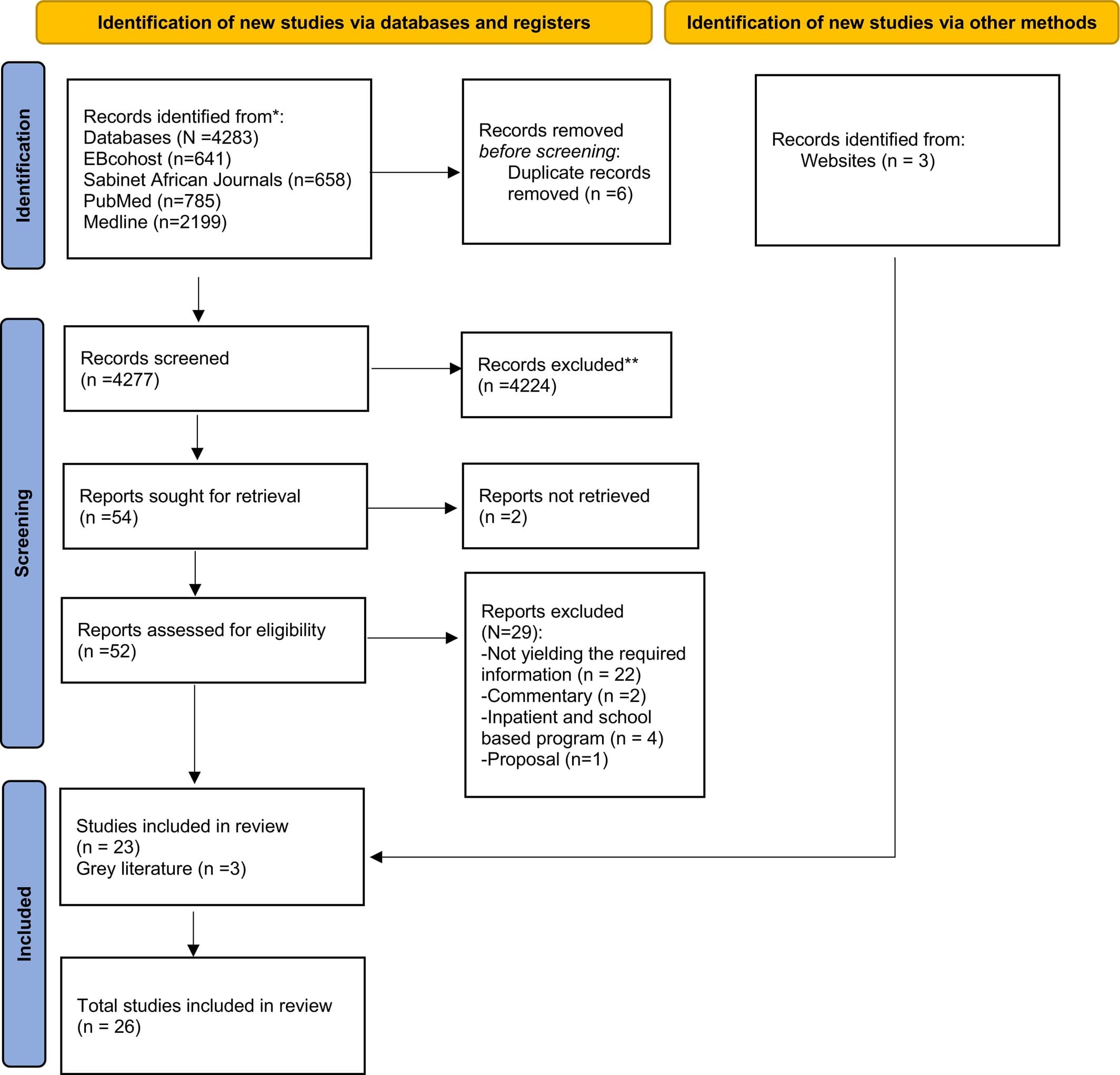
Figure 1. PRISMA flowchart for search strategy.
2.3 Data Evaluation
All studies included in the ILR underwent a critical appraisal for quality using the Mixed Methods Appraisal Tool (MMAT) version 2018. Since ILR allows a broad search for evidence, the quality appraisal process enabled researchers to assess empirical studies from diverse methodologies. In the bid to ensure quality results, the reviewers independently conducted a quality appraisal of the studies. The quality ratings of each criterion and the overall score for each study were assessed. However, studies were not excluded from the review based on their methodological quality to avoid inadequate reporting practices and possible exclusion of valuable findings (Lubbe, ten Ham-Baloyi, and Smit 2020; Whittemore and Knafl 2005). Thus, the researchers were able to identify broad evidence regarding substance use relapse prevention programme for the youth.
2.4 Data Synthesis and Analysis
Data analysis involves organising and synthesising data to answer a research question (Polit and Beck 2017). Data analysis for this review was guided by the integrative review process of Whittemore and Knafl (2005). It is during data analysis that the researchers conducted data extraction and data synthesis using content analysis (Lubbe, ten Ham-Baloyi, and Smit 2020). The researchers developed a data extraction table for the identified articles and captured the author's names (first author), the aim of the study, the methodology used and the findings (Lubbe, ten Ham-Baloyi, and Smit 2020) (Table 1). During data synthesis, the researchers engaged in a creative process in which interrelated ideas from various studies were clustered to develop a new understanding of substance use relapse prevention (Grove and Gray 2022). The data from primary sources were ordered, coded, categorised and synthesised into a coherent, integrated conclusion about programme for the prevention of substance use relapse (Whittemore and Knafl 2005). The researchers independently reviewed the articles to avoid biases and for consensus on the identified themes and subthemes (Toronto and Remington 2020). Subsequently, this interactive process resulted in the identification of three themes and their subthemes for the review. The identified themes and subthemes are displayed in Table 2.
Table 1. Appraisal of documents for substance use relapse prevention programmes.
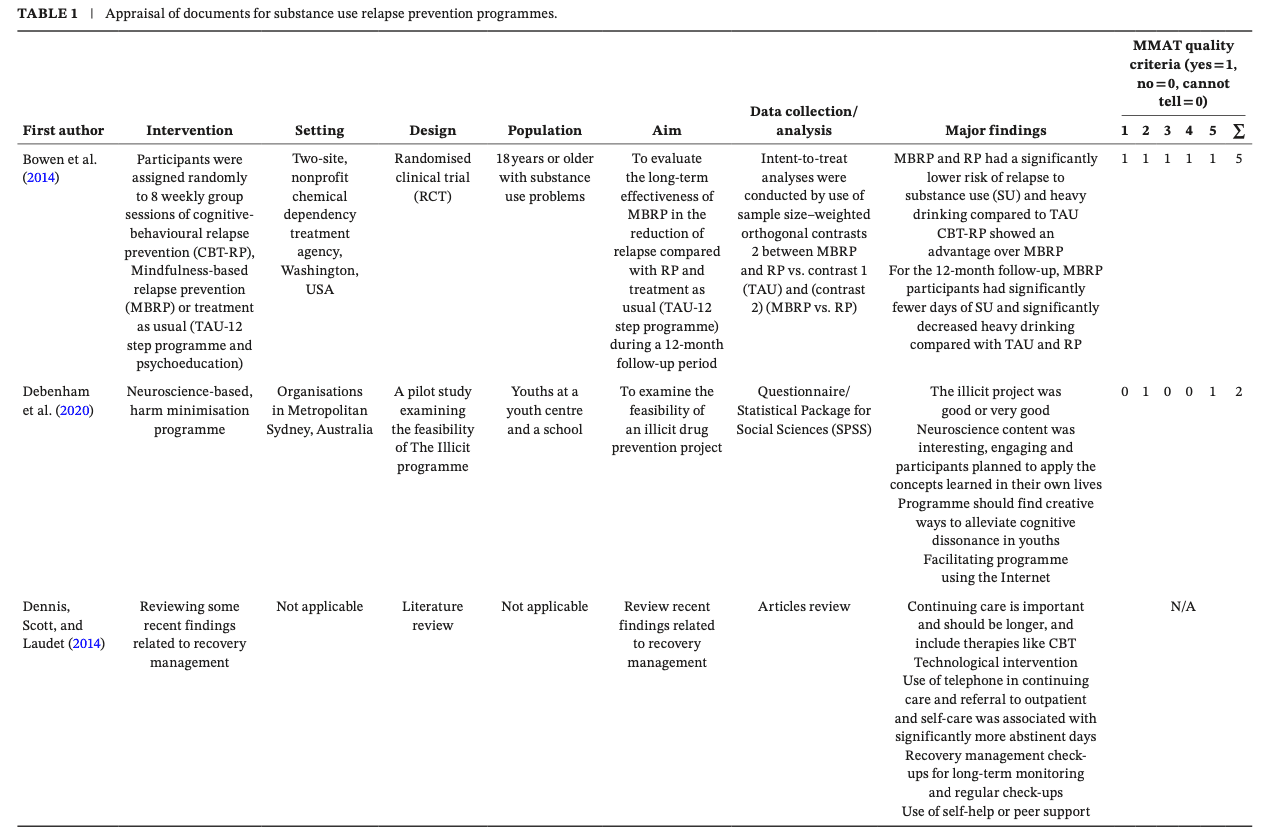

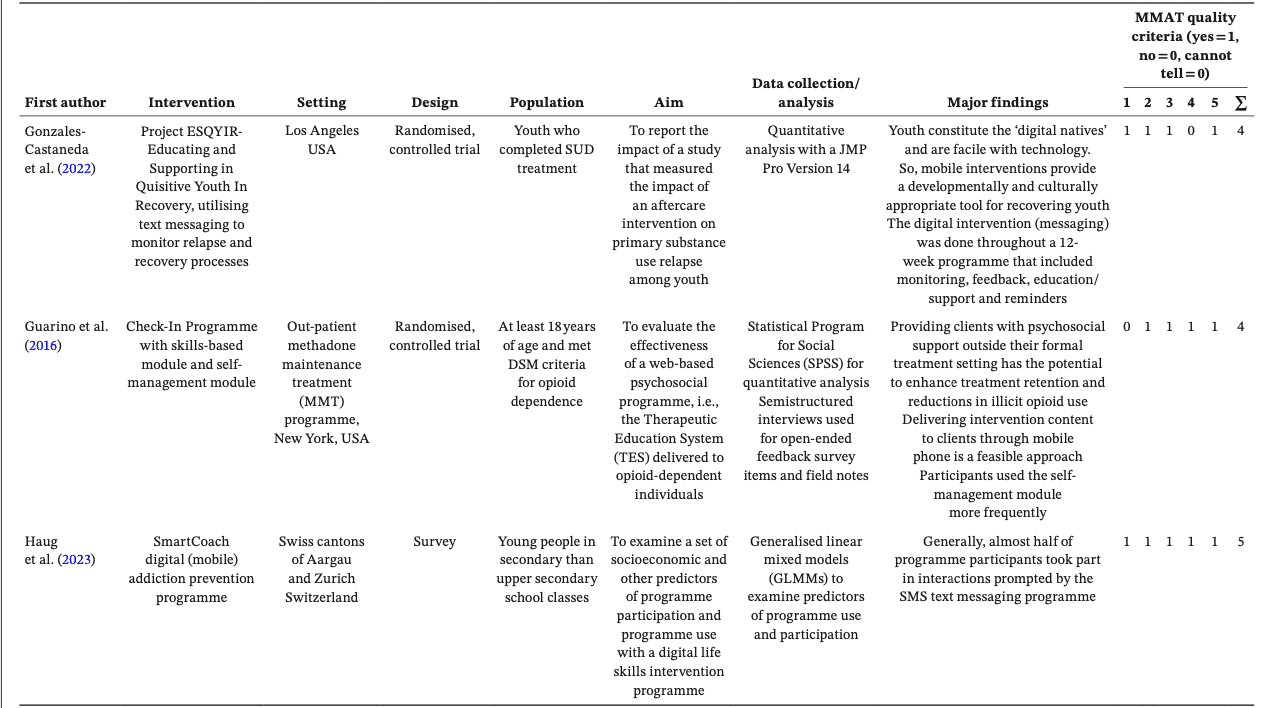
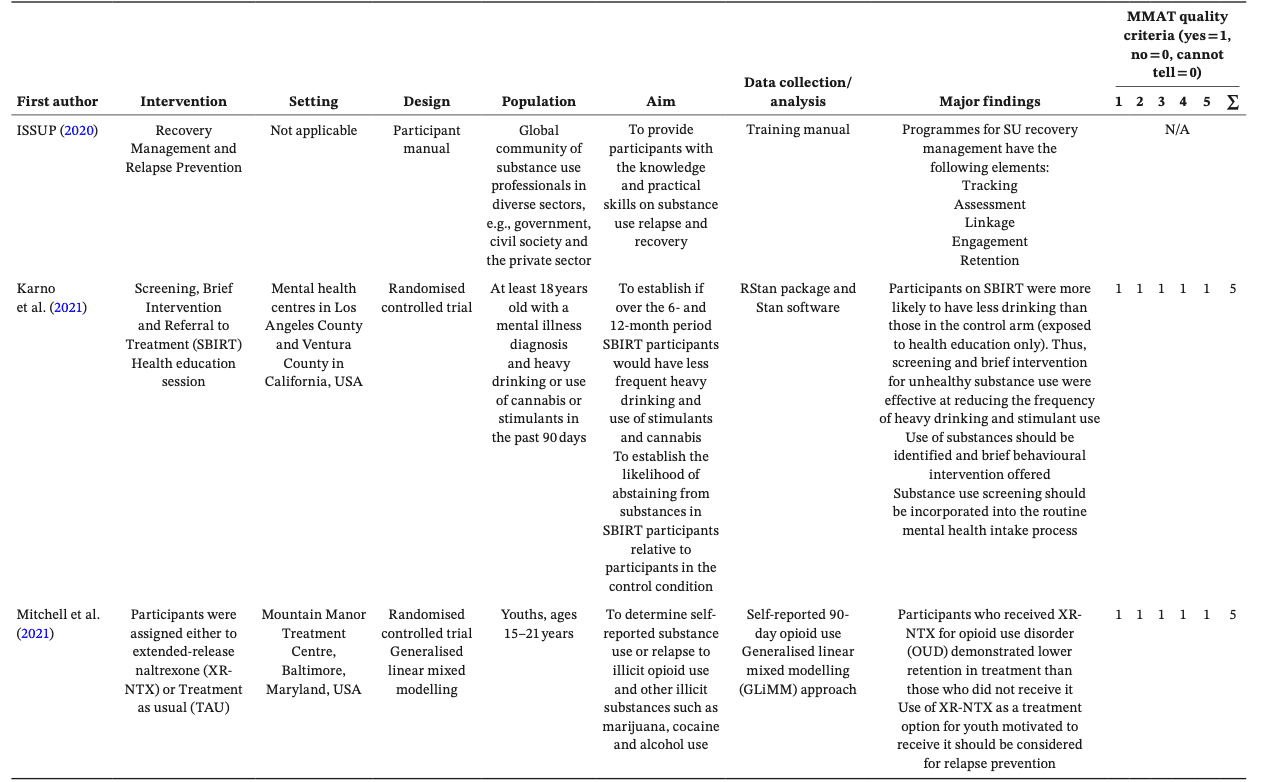

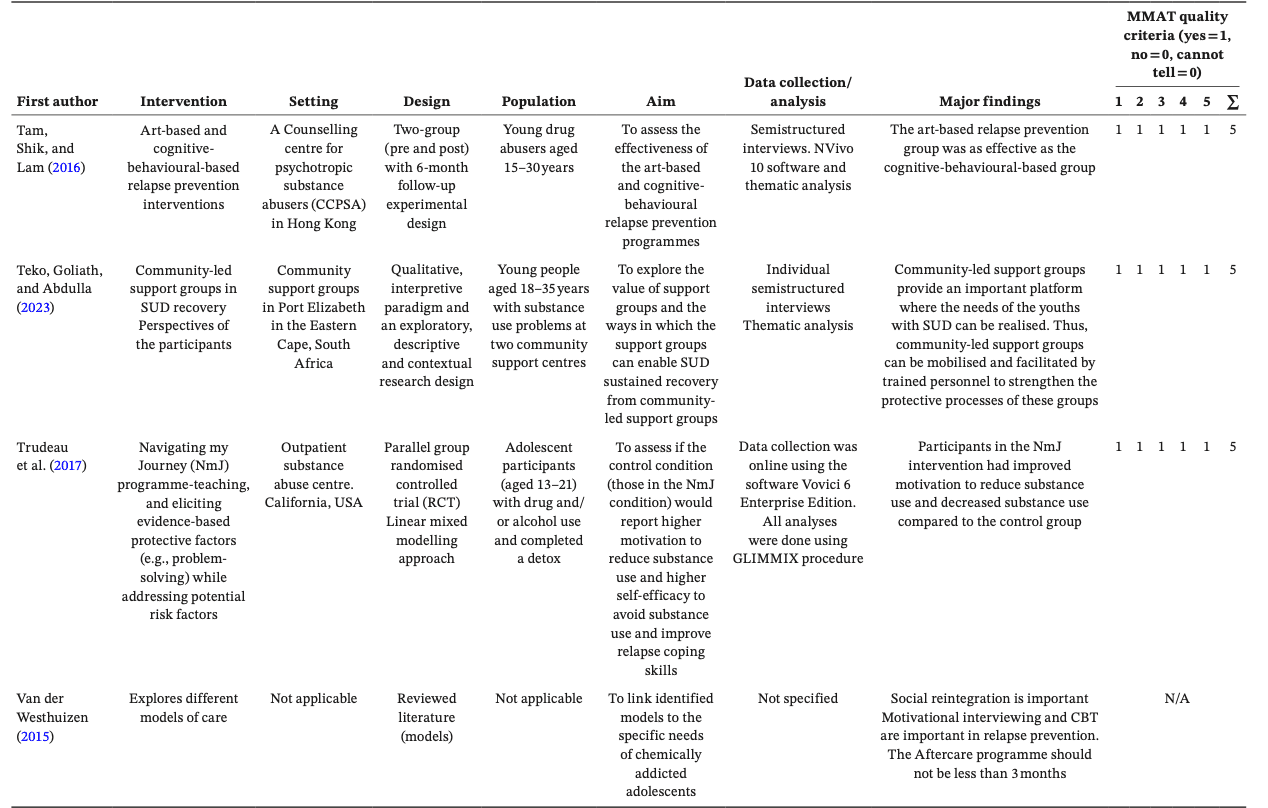
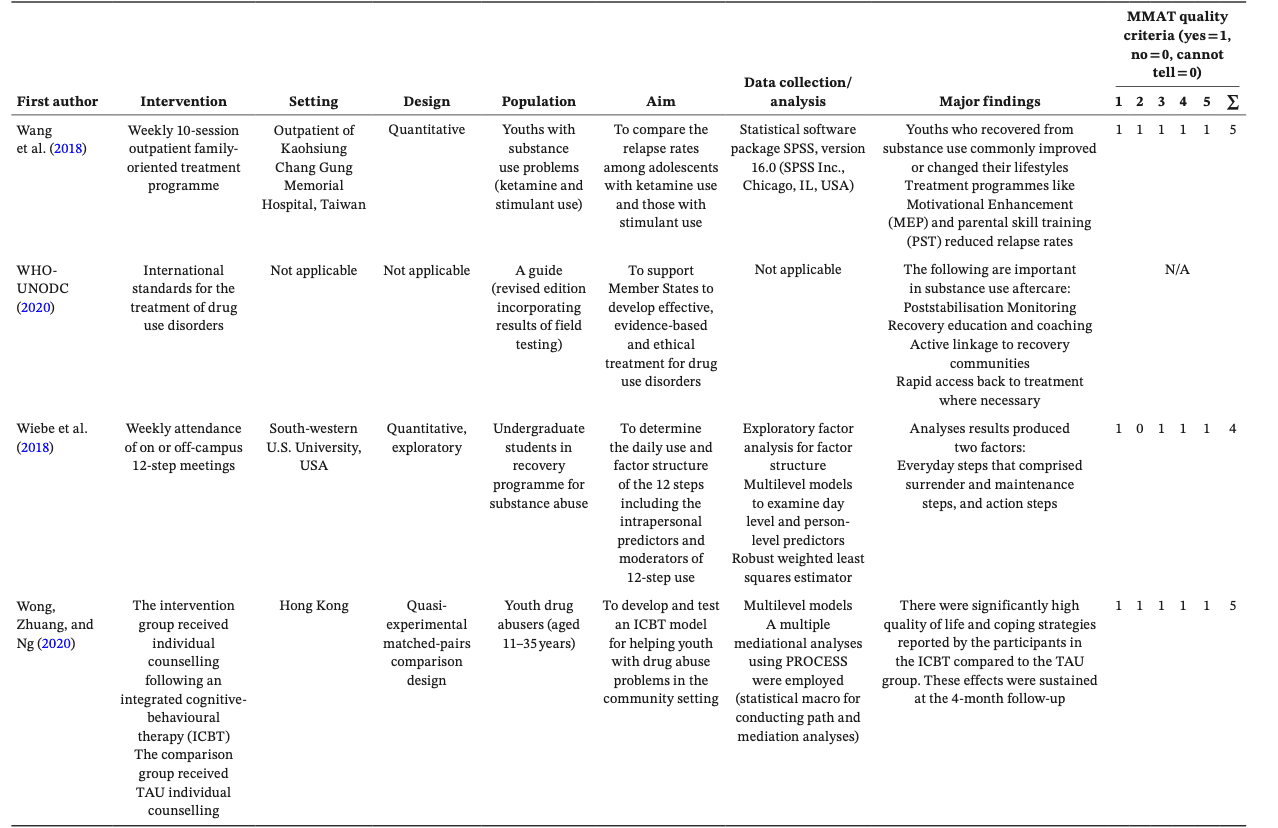

Table 2. Themes and sub-themes on the prevention of SUR.
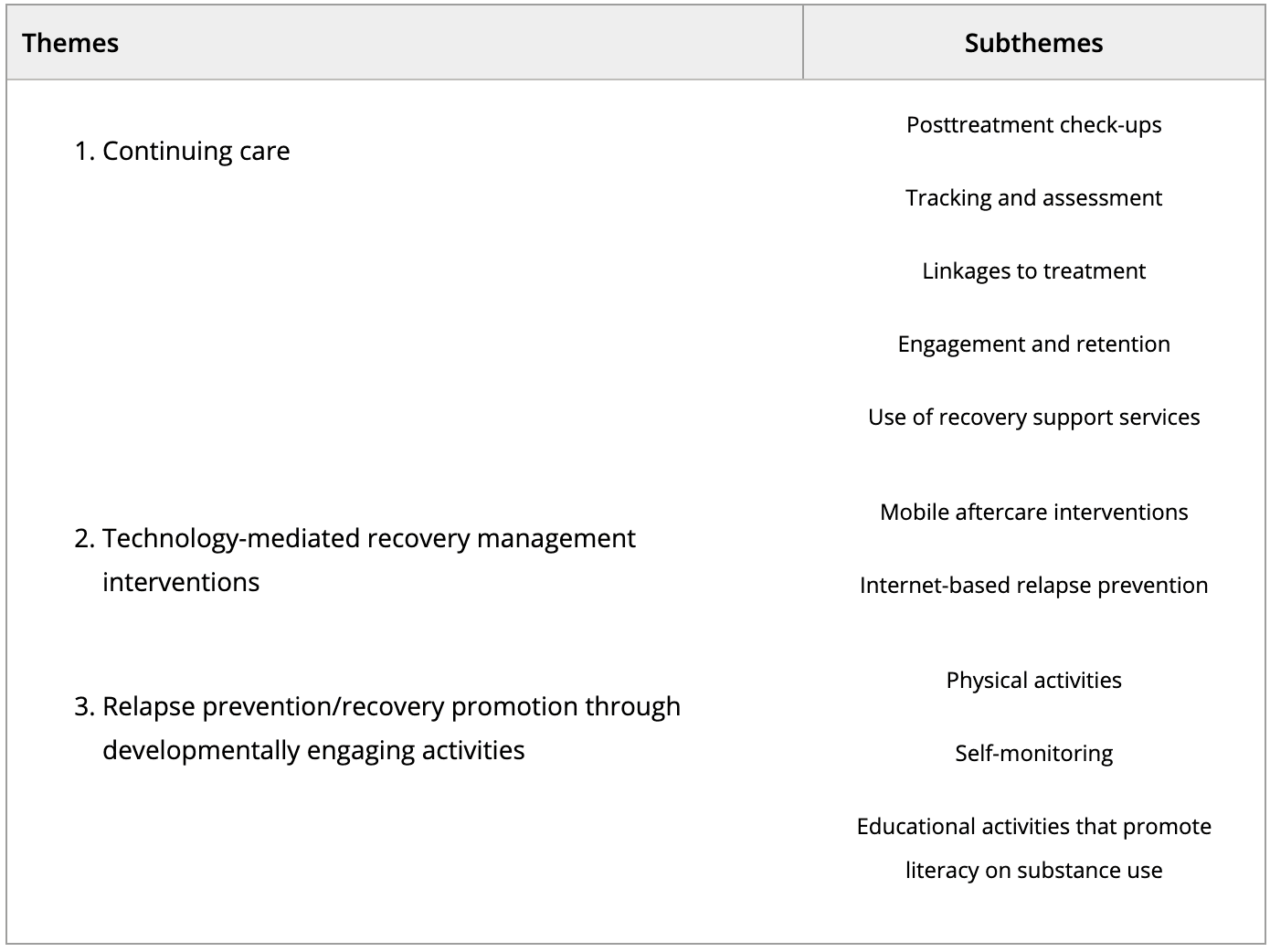
2.5 Ethical Considerations
This article adhered to all ethical standards for research without direct contact with human or animal subjects. The article is a component of a larger study and aims to guide the development of a substance use relapse prevention programme for the youth in Botswana. The study has the ethical approval of the Institutional Review Board of North-West University (Ethics number: NWU-00174-23-S1) and permission from the Ministry of Health IRB (Ref: HPRD: 6/14/1). Permission to conduct the study was also solicited from Sbrana Psychiatric Hospital Institutional Review Board (Ref: 4/2/2 III (65)).
3 Findings
Twenty-six articles were selected using the identified search strategy based on keywords (‘substance OR drug’; AND ‘use OR abuse OR misuse’; ‘relapse prevention OR addiction management’ AND programme OR check-ups' AND ‘youth OR young adults OR young people’). The review has been reported using the Preferred Reporting Items for Systematic Reviews and Data Analysis. The PRISMA flow chart is an internationally recognised diagram that provides a visual summary of the process used to include and exclude studies in systematic reviews (Page et al. 2021). The PRISMA flow diagram (Figure 1) summarises the search and screening processes used to select the articles. From the 26 articles, 23 were peer reviewed articles and 3 were grey literature. The 23 articles used in this review spanned the period from 2013 to 2024 with most studies conducted between 2017 and 2023 (Figure 2). The studies were conducted in six countries, and more than half of the selected studies were conducted in USA (n = 12). Other studies were conducted in South Africa (n = 2), Taiwan (n = 2), Australia (n = 2), Hong Kong (n = 2) and Switzerland (n = 1). The majority of the studies were randomised controlled trials (RCT) (n = 13) followed by quantitative studies (n = 4). Mixed methods, qualitative and literature review were each two (n = 6) and three (n = 3) from grey literature. The details and characteristics of each study are provided in Table 1.
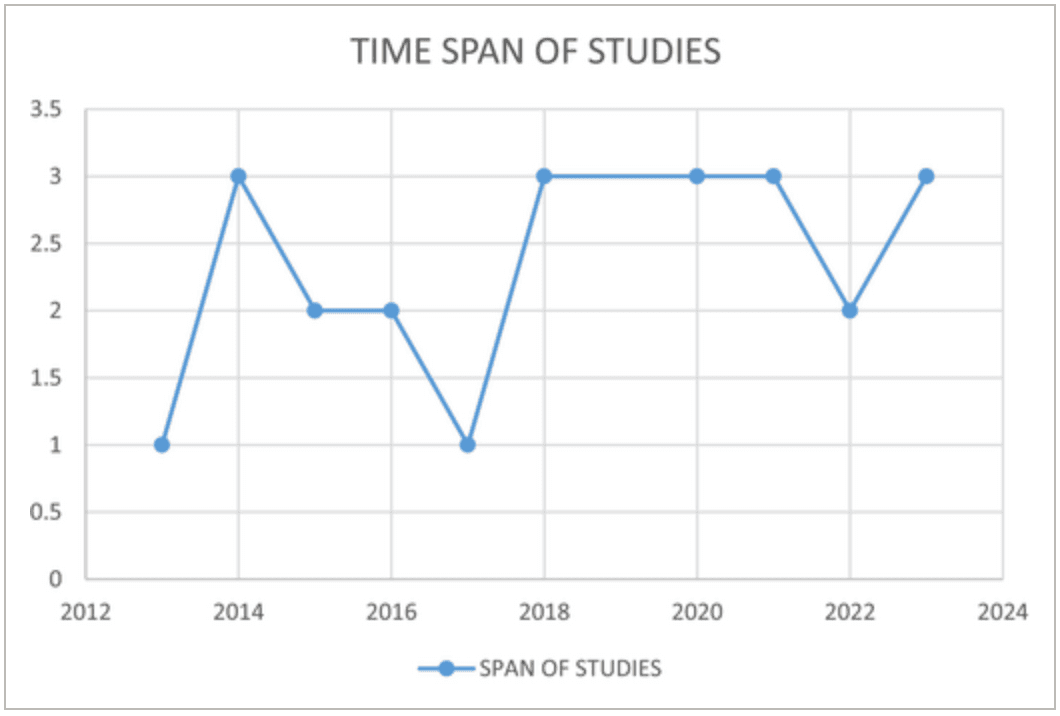
Figure 2. Time span for the selected studies.
3.1 Theme 1: Continuing Care
One of the main themes was continuing care. The initiation and sustenance of behavioural modifications in SUR prevention are discrete procedures that are regulated by certain circumstances (NIDA 2018). Accordingly, various authors concur that to keep young people from relapsing, it is necessary to provide ongoing care after release from the hospital to preserve the progress made during an admission (Bowen et al. 2014; Gonzales, Douglas Anglin, and Glik 2014; ISSUP 2020; Mpanza, Govender, and Voce 2022; NIDA 2018; Scott et al. 2018). The review also demonstrates that the aftercare programme (continued care) should not last for less than 3 months to achieve relapse prevention (Van der Westhuizen 2015). Check-ups following treatment, monitoring and evaluation, connections to therapy, engagement and retention and utilisation of recovery support programmes are all examples of continuing care.
3.1.1 Posttreatment Check-Ups
According to the review's findings, posttreatment check-ups, which are a component of continuing care or recovery management care (RMC), are beneficial for society's financial health and play a significant role in preventing substance use relapses (Dennis, Scott, and Laudet 2014; Gonzales-Castaneda et al. 2022; NIDA 2018; WHO-UNODC 2020). Dennis, Scott, and Laudet (2014) state that posttreatment check-ups are routine, ongoing assessments of substance users to identify relapses early and take appropriate action. According to the literature, posttreatment check-ups can be conducted through programmes that involve in-person interactions with youth substance users (YSUs) to strengthen their behavioural and cognitive abilities so they can withstand relapse temptations (Tam, Shik, and Lam 2016; ISSUP 2020). While YSUs are aware of where to turn for support, their biggest obstacle is finding the will to ask for it or to know when to do so (Debenham et al. 2020). To enable young people to participate in health-seeking behaviour at an early age, the relapse prevention programme with posttreatment check-ups would, thus, concentrate on increasing their motivation and setting positive, realistic health goals (Debenham et al. 2020; NIDA 2018; Trudeau et al. 2017; Wang et al. 2018).
Nonetheless, the results of this review make it clear that YSUs require assistance in becoming conscious of their cravings and triggers, or in identifying the cognitive, emotional and behavioural dysfunctions that cause them to relapse into substance use, as part of posttreatment check-ups (Bowen et al. 2014; NIDA 2018). Studies agree that one of the best strategies for treating individuals with substance use disorders is cognitive behavioural therapy (CBT) (Bowen et al. 2014; NIDA 2018; Wong, Zhuang, and Ng 2020). Thus, behavioural and cognitive strategies—either as individual or group therapies—are essential to reducing the likelihood of relapse and easing the cognitive dissonance that often follows in young people's positive behaviour change (Debenham et al. 2020; Tam, Shik, and Lam 2016). Therefore, developing skills to manage urges and postpone gratification, motivation for change, problem-solving abilities and the ability to engage in nonchemical substance use activities may be among the areas to be addressed at check-ups (NIDA 2018; WHO-UNODC 2020; Van der Westhuizen 2015; You et al. 2020).
3.1.2 Tracking and Assessment
The results of this review indicate that monitoring is part of continuous care that requires both assessment and tracking (Dennis, Scott, and Laudet 2014; Karno et al. 2021; NIDA 2018; Scott et al. 2023, 2018). YSUs are proactively tracked and screened (assessed) for early indications of issues, given incentives, and assisted in negotiating access for re-entry into treatment, among other various functions of continuing care (ISSUP 2020; Scott et al. 2018). The recovery management and relapse prevention manual, also known as the Universal Treatment Curriculum for Substance Use Disorders (UTC), demonstrates the significance of tracking and the proactive steps taken to stay in touch with substance users after they are discharged from treatment (ISSUP 2020).
Fieldwork, phone calls, mailings and other methods are all combined in the tracking process (ISSUP 2020). After that, the drug user is evaluated to rule out SUR and choose the best course of action. To improve outcomes, YSU assessments must be carried out quarterly as part of monitoring for approximately 4 years after discharge (ISSUP 2020; Scott et al. 2018). Consequently, monitoring and evaluation determine whether an individual with a substance use disorder has resumed substance use and allow for intervention to prevent a relapse or lessen its effects (ISSUP 2020).
3.1.3 Linkages to Treatment
During assessment, some YSUs may have relapsed or be on the verge of a relapse. Thus, YSUs in primary care settings require an assertive and robust linkage model that can effectively increase their participation in SUD treatment, leading to significantly greater reductions in drug use (Scott et al. 2018). In situations where relapse is imminent, linking YSUs back to treatment is necessary, thus increasing re-entry into treatment before a relapse can occur (Dennis, Scott, and Laudet 2014; Karno et al. 2021). Literature provides overwhelming evidence of the effectiveness and value of ‘referral back to treatment’ to prevent relapses to substances (NIDA 2018). In the cases where relapse is imminent, suspected or real, individuals are linked back to inpatient treatment, residential services, SUD outpatient services or community support services to prevent a relapse or minimise its impact (ISSUP 2020).
3.1.4 Engagement and Retention
The literature (NIDA 2018; Scott et al. 2023, 2018) also emphasises the significance of engagement and retention as a component of ongoing treatment to prevent SUR. The engagement component aims to avoid the common roadblocks found throughout the admissions process, allowing substance users to more easily ‘show’ up for treatment following evaluation and referral (ISSUP 2020). To increase the possibility that YSUs will attend treatment after assessment, the engagement process includes putting tactics in place to boost motivation for re-entry into treatment, expediting the admissions process, and overcoming some of the admissions course's drawbacks (ISSUP 2020; NIDA 2018). After a successful engagement process with the willingness of the YSU to show up to treatment, the primary healthcare linkage manager (focal person) must continue to maintain contact and follow-up with the substance user to ensure that motivation to participate in treatment is maintained to aid retention (ISSUP 2020; Scott et al. 2018). The linkage manager must provide assistance to overcome any environmental or organisational barriers to retention (Scott et al. 2018).
According to the review's conclusions, the retention component of relapse prevention aims to keep substance users in treatment for a minimum of 14 days, either through inpatient or residential treatment, or 14 sessions of outpatient therapy (ISSUP 2020). To minimise the harm associated with relapse or to sustain substance abstinence, engagement and retention methods are crucial (Scott et al. 2018). The treatment personnel must inform the linkage manager if the YSU makes threats to stop treatment or misses an outpatient visit. The linkage manager then sets up an intervention to encourage re-engagement in treatment (Scott et al. 2018). Mitchell et al. (2021) emphasised the need for appropriate pharmaceutical treatment postdischarge to prevent relapses and sustain retention to treatment.
3.1.5 Use of Recovery Support Services
According to the review, recovery support services are necessary and encourage healthy behaviours after completing a treatment programme to reduce the risk of a relapse (ISSUP 2020; Mpanza, Govender, and Voce 2022; NIDA 2018). Linking YSUs to recovery support services is crucial as part of reintegration (Van der Westhuizen 2015). The findings of this review indicate that reintegration can be social (social-reintegration) in which YSUs are assisted to re-establish themselves into the community through networking with families, schools, churches and support groups (NIDA 2018; WHO-UNODC 2020). Mpanza, Govender, and Voce (2022) emphasise the need for recovery support services to comprehensively reintegrate people with substance use problems into their families, workplaces and communities. According to the foregoing author, the goal of recovery support services is to provide tools and resources to sustain the recovery of YSUs after the formal treatment programme has been completed.
Additionally, it is evident from this review that participation in recovery support services with more rewarding activities is a key predictor of long-term recovery (Mpanza, Govender, and Voce 2022). Precisely, the use of recovery support services that aid social integration and participation in conventional pursuits, such as alcohol-free recreational/art-based activities and linkages to job placement programmes, is associated with a higher prospect of stable remission and recovery (Mpanza, Govender, and Voce 2022; Tam, Shik, and Lam 2016). Furthermore, the review shows that engagement in peer support groups such as the 12-step programme is associated with recovery because it provides a conducive environment for establishing positive social relationships, a space for learning new skills and information on health and employment (Mpanza, Govender, and Voce 2022; NIDA 2018). However, it is worth noting from this review that availing resources for recovery support services such as rehabilitation centres in communities is a crucial strategy that facilitates the prevention of relapses and offers an opportunity for the YSUs to effectively and sufficiently address their substance use problems (WHO-UNODC 2020).
3.2 Theme 2: Technology-Mediated Recovery Management Interventions
One of the themes from the review was technology-mediated aftercare intervention (TMAI). The use of TMAI, such as mobile aftercare interventions and internet-based relapse prevention, plays a critical role in preventing relapses among youths either as a standalone or as an adjunct to face-to-face interventions.
3.2.1 Mobile Aftercare Interventions
Mobile aftercare intervention is one of the subthemes that emerged in this review under technology-mediated management interventions. Mobile aftercare interventions can be delivered through smartphone applications or general text messages (SMS) (Gonzales et al. 2014; Gonzales-Castaneda et al. 2022; Guarino et al. 2016; Haug et al. 2023). From the results of the review, practitioners can continue offering care through text messages to motivate the YSUs to engage in recovery behaviours and to continue making positive life changes (Gonzales, Douglas Anglin, and Glik 2014). Furthermore, Gonzales, Douglas Anglin, and Glik (2014) found that the mobile texting intervention buffered the tendency towards relapse and significantly reduced the severity of substance use among youth who received the aftercare mobile texting intervention compared to the youth in the standard aftercare control condition. Finally, the findings of this review indicate that mobile texting aftercare programme offers several advantages that include personalised and targeted engagement, enhanced assessment and monitoring, increased convenience and better flexibility of service delivery (Gonzales, Douglas Anglin, and Glik 2014).
3.2.2 Internet-Based Relapse Prevention
Another subtheme that emerged in the review was internet-based relapse prevention. Internet-based relapse prevention programming is reported to be a promising modality to enhance treatment gains and recovery (relapse prevention), though Trudeau et al. (2017) argue that it lacks a strong evidence base (Debenham et al. 2020; Dennis, Scott, and Laudet 2014). However, the findings of this review show that digital or internet-based health interventions can offer frequent monitoring of YSUs and address some of the barriers to health delivery, such as the fear of stigma associated with face-to-face interventions (Dennis, Scott, and Laudet 2014; Guarino et al. 2016). Thus, internet-based interventions can positively impact the provision of substance use prevention or harm reduction initiatives (Debenham et al. 2020; Dennis, Scott, and Laudet 2014; Guarino et al. 2016; Haug et al. 2023; Trudeau et al. 2017). Moreover, the review reveals that internet-based smartphone applications can be used for engagement, personalised feedback and to provide digital programme modules to be carried out over a time frame (Guarino et al. 2016; Haug et al. 2023).
3.3 Theme 3: Relapse Prevention/Recovery Promotion Through Developmentally Engaging Activities
The results of this review indicate the need for relapse prevention through developmentally engaging activities. This involves engaging YSUs on undertakings that have the potential to aid their personal growth and development while also serving as a deterrent to substance use and SUR (Gonzales et al. 2013; ISSUP 2020). Three subthemes were derived from the review: physical activities, educational activities that promote literacy on substance use and self-monitoring strategies.
3.3.1 Physical Activities
Evidence from the review shows that physical activities, for example, exercise programmes are efficacious in supporting substance use relapse prevention among the youth, especially as a complement to cognitive-behavioural/lifestyle interventions (Furzer et al. 2021; Gonzales et al. 2013; NIDA 2018; Wong, Zhuang, and Ng 2020). This review demonstrates that the youth who engage in a substance use programme that has physical activities (e.g., exercises) develop enhanced self-esteem, high relapse prevention efficacy, increased levels of exercise enjoyment and better physical health perceptions (Furzer et al. 2021; Mpanza, Govender, and Voce 2022). However, behaviour change for the youth requires joyful activities (recreational, art-based, etc.) that can replace substances (Tam, Shik, and Lam 2016; Van der Westhuizen 2015).
3.3.2 Self-Monitoring
Additionally, the review shows that YSUs need to be empowered with self-monitoring strategies, for example, use of a diary or technology-mediated self-monitoring interventions (Dennis, Scott, and Laudet 2014; Gonzales et al. 2014; Haug et al. 2023; NIDA 2018; Wiebe et al. 2018). Basically, self-monitoring activities as a relapse prevention and recovery promotion strategies have been found to assist the YSUs to self-regulate (self-control) specific and critical areas of their lives associated with relapse following inpatient treatment (Gonzales, Douglas Anglin, and Glik 2014; Guarino et al. 2016). Moreover, the self-monitoring reports are important to assess for discordance between the self-report data and sensitivity analyses (urinalysis) to compare if the self-report of a ‘no recent use’ is supported by substance-negative urinalysis (Karno et al. 2021).
3.3.3 Educational Activities That Promote Literacy on Substance Use
According to some sources of this review, YSUs need to be psycho-educated on key neuroscience principles to build their understanding of the brain functions, the impact of substances on the brain and substance use relapses (Debenham et al. 2020; Van der Westhuizen 2015). In a study by Debenham et al. (2020), YSUs who were provided with psychoeducation on neuroscience and the effects of drugs on the brain content found it interesting and these facts made it more believable, which can motivate them to quit and abstain. The psycho-education message has to be delivered in a creative way to stimulate interest in the YSUs, for example, a combination of art-based and cognitive-behavioural-based relapse prevention groups (Debenham et al. 2020; Tam, Shik, and Lam 2016).
4 Discussion
Youth substance use poses a significant problem since it causes dependency and makes it harder to stop using drugs later in life. Even after extended periods of abstinence, young people who begin using substances and attempt to stop generally relapse (Arora et al. 2015). Nevertheless, there is a paucity of empirical data about youth substance use relapse prevention programmes. However, the existing programmes have shown to be successful in preventing SUR and enhancing YSUs' general well-being. This is especially true in industrialised nations where several relapse prevention initiatives have been created and evaluated for effectiveness.
Surprisingly, this analysis shows that many nations in sub-Saharan Africa lack SUR preventive programmes, even though substance use is more widespread in this subregion. Consequently, more effort is invested in managing short-term addiction crises and offering limited aftercare programmes (Saba, Weir, and Aceves-Martins 2021). Recurring relapses and readmissions are, thus, a common result of such brief recovery therapies and the absence of SUR preventive programmes. While there are many different SUR prevention programmes, this review demonstrates that the most prevalent and effective are cognitive-behavioural-based programmes; nevertheless, other strategies, like mindfulness-based relapse prevention programmes, are also gaining traction.
Most of the authors in our review approached relapse and its prevention in a contextual manner, viewing cognitive and environmental processes as proximal antecedents of relapse. This perspective, however, is different from the one that links relapse to internal causes, such as desires, and views cravings as a sign of an underlying illness (Hendershot et al. 2011). According to Mitchell et al. (2021), the latter of the two perspectives suggests the necessity of pharmaceutical treatment for relapse prevention. The author highlights the importance of receiving proper pharmacological treatment after discharge to maintain treatment retention and prevent relapses.
Regarding the use of medicines for relapse prevention after discharge, the literature is, nevertheless, ambiguous. For example, in contrast to the American Academy of Paediatrics recommendations, the U.S. treatment system prioritises nonmedication treatment for young people (Mitchell et al. 2021). However, most of the programmes in our research focused on providing psychosocial support, like ongoing care to avoid SUR. Sustaining treatment beyond in-patient discharge is essential for preventing youth substance use relapse (Gonzales et al. 2014; ISSUP 2020; Mpanza, Govender, and Voce 2022). Face-to-face interactions can be used to provide ongoing care. It can be utilised to equip YSUs with the abilities to recognise the cognitive, emotional and behavioural dysfunctions that lead to relapse and to resist relapse temptations (ISSUP 2020; Tam, Shik, and Lam 2016). Health professionals in charge of the SUR prevention programmes ought to inspire YSUs to make changes and develop their capacity for problem-solving and postponing pleasure (NIDA 2018; WHO-UNODC 2020; Van der Westhuizen 2015). Nonetheless, Van der Westhuizen (2015) reported that a successful SUR prevention programme must be provided for a minimum of 3 months and ought to be sufficiently potent to assist the YSUs in fending off a relapse. People in charge of the SUR prevention programme must keep an eye on and sustain positive behaviour change during the continuing care phase to avoid a relapse. Therefore, the focus should be on strengthening the YSUs' ability to resist a potential relapse and connecting them even more to the resources that are out there for help.
According to the review's findings, connecting substance users with recovery-focused programmes is essential for their reintegration and support (ISSUP 2020; Van der Westhuizen 2015). Through networking with families, schools, churches and support groups, YSUs are helped to re-establish themselves into the community during reintegration to promote sustainable rehabilitation (WHO-UNODC 2020; Mpanza, Govender, and Voce 2022; Teko, Goliath, and Abdulla 2023). Research suggests that social integration support services, job/vocational placement programmes and participation in engaging activities all increase the likelihood of successful recovery and prevent relapses (Gonzales et al. 2013; Mpanza, Govender, and Voce 2022; Tam, Shik, and Lam 2016). Moreover, residential care and rehabilitation facilities are crucial in offering a variety of recovery support programmes that can adequately and successfully treat substance use disorders in individuals who are referred back to them for treatment (Dennis, Scott, and Laudet 2014; Scott et al. 2023; WHO-UNODC 2020).
The importance and efficacy of technology-mediated SUR prevention programmes are supported by a small but increasing body of research, particularly when combined with more conventional, in-person therapy approaches. According to our findings, services for young people who require support with substance use should be tailored to their individual needs. Gonzales-Castaneda et al. (2022) argue that due to their familiarity with technology, young people can be considered ‘digital natives’. Therefore, to effectively and significantly reach out to young people, technology can provide targeted, tailored interventions and links to therapy as an auxiliary to in-person interventions.
Technology-mediated aftercare interventions (TMAI) can be provided by text message, internet-based digital health care or smartphone applications (Gonzales, Douglas Anglin, and Glik 2014). The linkage manager or focal person in charge of the SUR prevention programme can provide individualised care through the use of text messages or online resources if the usage of TMAI is approved. TMAI can minimise the risk of relapses through active participation in technological recovery-oriented activities that foster positive life changes. Both personalised feedback and engagement are enhanced through TMAI. For example, YSUs can receive text messages on how to avoid a relapse, substance abuse education, daily self-monitoring, available community support resources, and they can even participate in digital programme modules (Dennis, Scott, and Laudet 2014; Gonzales, Douglas Anglin, and Glik 2014).
Programmes for the prevention of SUR in youth also need to encourage mental and physical growth (Furzer et al. 2021; ISSUP 2020). To replace the hedonic experience of substances, the programme activities need to be pleasurable (Furzer et al. 2021). According to our research, these kinds of activities ought to promote individual development and act as a disincentive to SUR (Gonzales et al. 2013; ISSUP 2020). Exercise programmes are effective in preventing youth substance use relapses, according to a body of research, especially when they are implemented in conjunction with cognitive-behavioural/lifestyle change interventions (Furzer et al. 2021; Wong, Zhuang, and Ng 2020). It is necessary to replace the hedonistic experience of drugs with such joyful activities if young people are to have better chances of changing their behaviour (Furzer et al. 2021). Engaging in physical exercise has been shown to improve perceptions of physical health and self-esteem (Furzer et al. 2021).
However, educational initiatives that promote literacy around substance use and SUR must be combined with physical activities (Van der Westhuizen 2015). YSUs should receive psychoeducation on the fundamental neurobiological concepts underlying habit and addictive behaviours in order to achieve this goal (Debenham et al. 2020). According to our review, youngsters find knowledge about brain processes and their connection to substance use and relapse to be motivating while trying to quit drugs (Debenham et al. 2020; Van der Westhuizen 2015). Like joyful activities, the psycho-education message needs to be presented in an original manner to pique certain young people's interest (Debenham et al. 2020; Tam, Shik, and Lam 2016). Additionally, self-monitoring techniques can be used to psycho-educate YSUs (Gonzales et al. 2014). Practitioners can evaluate whether there is a discrepancy between the self-report data and sensitivity analysis (urinalysis) using the self-monitoring reports that they generate (Karno et al. 2021). A drug-negative test must substantiate a self-report that excludes any recent substance usage.
4.1 Strengths and Limitations of the Review
With the use of this integrative literature review, which offered a strong and practical methodology, a thorough understanding of youth substance use relapse prevention was obtained by integrating the research findings from various study designs. This is the first review on the subject that we are aware of. Nonetheless, this review has certain methodological shortcomings. First, there was bias in the language. The publications that were written in English were the subject of the review. As a result, it is possible that the reviewers overlooked important and pertinent material written in another language. Second, it is possible that some important publications that were not indexed by the chosen databases escaped the reviewers' notice.
Therefore, to reduce this risk, all pertinent studies were found by doing an article search utilising interchangeable or alternative key terms, such as ‘substance OR drug’ and ‘use OR abuse OR misuse’. However, selection bias would have also happened as a result of human error brought on by handling a large number of search results because of the high search sensitivity. However, the reviewers took precautions by reviewing the search results again and screening again to make sure certain important items were not overlooked.
4.2 Strengths and Limitations of the Literature
The information gleaned from this analysis contributes to the expanding body of research on youth substance use relapse prevention programmes. The review provides some insight into the crucial steps required to create the SUR preventive programme's preventative tactics. The study makes it abundantly evident that the youth's programme entails ongoing evaluations, supervision and re-intervention to either lessen the severity of a relapse or maybe re-enter treatment before it happens. Nonetheless, there remained a paucity of research on youth relapse prevention programmes, particularly in Africa. Furthermore, the majority of the review's conclusions focus on American situations, which can lack the qualities of regional contexts. The review also included grey literature. Despite the lack of peer review, the grey literature and material can provide valuable information to address the study topic (Adams et al. 2016). Evidence syntheses on SUR prevention programmes for young people included information from grey literature and other sources that were deemed reliable and pertinent to address the study topic.
4.3 Implication for Practice
In the community, mental health workers such as psychiatric nurses provide care and assist in the rehabilitation of individuals with SUDs. They must comprehend how substance use relapse can be prevented, particularly among the young, since they oversee substance use prevention programmes and SUR prevention programmes (tertiary prevention). Particularly in Africa, where mental health professionals such as psychiatric nurses are sent to serve rural communities as the only mental health professionals in their catchment areas, they play a crucial role in the provision of mental health care. Therefore, mental health workers must comprehend the components of a youth substance use relapse prevention programme. The review's findings are critical to the field of mental health and psychiatry, and they are released at a critical juncture as mental health professionals around the world struggle to find effective ways to reduce drug-related relapses that impede successful recovery. The results hold the potential to offer well-informed and comprehensive preventive care, ending the never-ending cycle of treating recurrent cases of substance use.
5 Conclusion
The prevention of substance use relapse in young people with substance use disorders was the main emphasis of this review. Youth SUR prevention must be thorough and realistic enough to touch all facets of their lives. As a result, the youth SUR prevention programme needs to be comprehensive, sensitive to their needs and supportive of partnerships with families, community support agencies, and so on. The review emphasised important components of a successful substance use programme, including ongoing follow-ups after treatment and evaluations to identify relapses and take immediate action. The evaluations and check-ups provide connections for harm reduction in the event of a relapse or for re-entry into treatment before a relapse. In addition, the YSUs are equipped with the knowledge and abilities to resist psycho-social influences that may cause them to relapse.